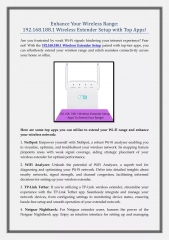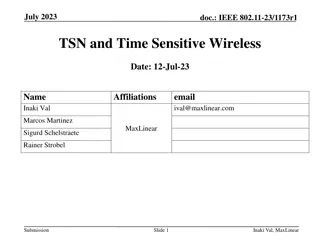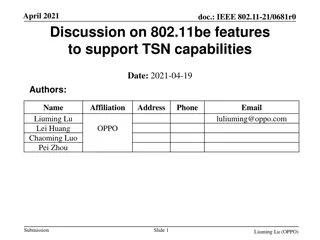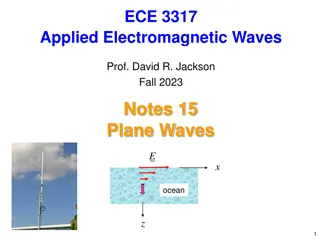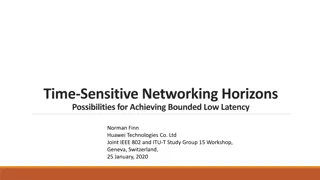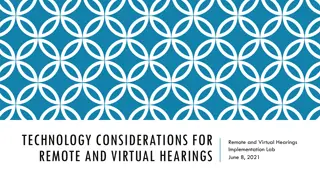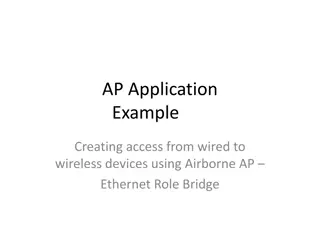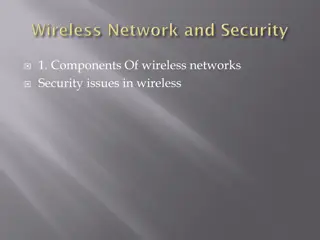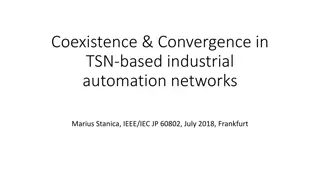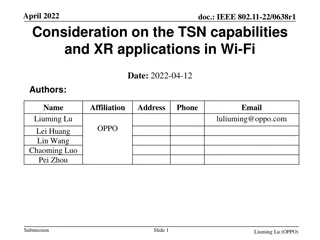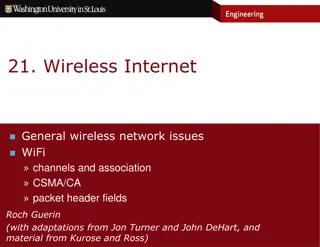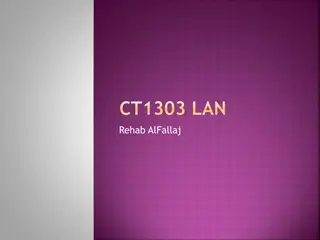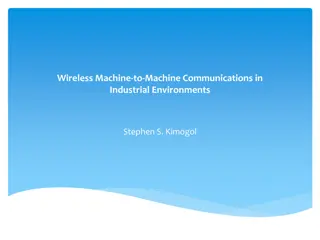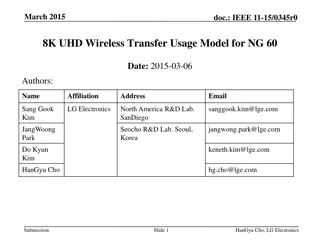Challenges and Solutions in Wired-Wireless TSN Configuration
This document discusses the challenges faced in configuring and managing wired-wireless TSN domains, focusing on the unique aspects of wireless networks such as fading, variable delays, and shared medium access. It presents models for physical and logical integration of wired and wireless TSN, emphasizing the need for abstraction and centralized control to address mobility and fading issues effectively.
Download Presentation

Please find below an Image/Link to download the presentation.
The content on the website is provided AS IS for your information and personal use only. It may not be sold, licensed, or shared on other websites without obtaining consent from the author. Download presentation by click this link. If you encounter any issues during the download, it is possible that the publisher has removed the file from their server.
E N D
Presentation Transcript
April 2021 doc.: IEEE 802.11-21/0668r0 Wired-Wireless TSN Configuration and Management Date: 2021-04-20 Authors: Name Malcolm Smith Affiliations Cisco Systems Inc. Address Phone email mmsmith@cisco.com maseewal@cisco.com Maik Seewald dave.cavalcanti@intel.com Dave Cavalcanti Intel Corp. javier.perez- ramirez@intel.com juan.fang@intel.com Javier Perez-Ramirez Juan Fang Submission Slide 1 Malcolm Smith, Cisco
April 2021 doc.: IEEE 802.11-21/0668r0 Introduction This presentation reviews the architecture, assumptions and requirements for an 802.11 BSS operation as a Wireless TSN bridge It also discusses wireless challenges to be considered in the configuration & management of wired-wireless TSN domains and identifies potential areas for enhancement and collaboration between 802.1 and 802.11 Submission Slide 2
April 2021 doc.: IEEE 802.11-21/0668r0 Challenges of wireless networks (incl. 802.11) Wireless is different from other mediums in the 802.1 TSN ecosystem Fading leads to a wide variation in transmission speed (e.g. 1000->100Mb/s) Shared medium access can cause variable delay and jitter (e.g. random backoff) Path loss variability and STA mobility can cause change in best serving AP and thus TSN Bridge end-point Thus, physical path from TSN talker to listener can change significantly! Question: where in TSN architecture is this accounted for or abstracted ? Submission Slide 3 Malcolm Smith, Cisco
April 2021 doc.: IEEE 802.11-21/0668r0 Physical Wired-Wireless 802.1 TSN integration model The CUC collects traffic stream requirements from end devices (Talkers/Listeners), e.g., over OPC_UA The CNC discovers the bridges capabilities Bridge parameters (802.1Qcc clause 12, 802.1Qdj) The CNC configures TSN capabilities at the bridges (e.g., using YANG/Netconf interface) CUC CNC End Device End Device TSN Bridge Wired TSN Domain WLAN Integration: AP can be seen as a Wireless TSN Bridge STAs can be configured as talkers or listeners CNC uses same abstraction for wired & wireless domains CNC needs to re-schedule upon every fading/mobility event End Device End Device Wireless TSN Access Point Wireless TSN Domain Control plane entities in a centralized management model (802.1 Qcc): CNC: Central Network Configuration CUC: Central User Configuration Submission Slide 4 Malcolm Smith, Cisco
April 2021 doc.: IEEE 802.11-21/0668r0 Logical Wired-Wireless 802.1 TSN integration model The CNC uses same abstraction for wired and wireless domains WTSN bridge abstracts mobility/fading CNC never reschedules CUC UNI CNC TSN Config. & Management Wired-TSN Stream Data TSN Bridges Stream Data Talker End Stations Listener End Stations Wireless-TSN Wireless TSN Bridge Stream Data Stream Data Wireless Listener End Stations Wireless Talker End Stations CNC: Central Network Configuration CUC: Central User Configuration Submission Slide 5 Malcolm Smith, Cisco
April 2021 doc.: IEEE 802.11-21/0668r0 Hybrid Wired-Wireless 802.1 TSN integration model WTSN Bridges form a WTSN Domain TSN CNC is aware of WTSN domain CNC adapts scheduling accordingly CUC UNI CNC TSN WTSN Wired-TSN Stream Data TSN Bridges Stream Data Talker End Stations Listener End Stations WTSN Domain* Wireless-TSN *AP/STA within WTSN domain support TSN (.1AS/Qbv) No TSN translation (TT) needed AP Stream Data Stream Data Wireless Listener End Stations Wireless Talker End Stations CNC: Central Network Configuration CUC: Central User Configuration Submission Slide 6 Malcolm Smith, Cisco
April 2021 doc.: IEEE 802.11-21/0668r0 Hybrid TSN integration model CNC is wireless aware and logical TSN bridge has known dynamic range Realistic range of MCS/data-rates can be used to report reasonable delay bounds to CNC CNC scheduling can account for wireless variability (e.g. 99.9%-ile vs. 100%-ile worst-case) Flexibility Designers can determine trade-off between necessity for gate re-computation vs. efficiency Systemic degradation can still be accommodated (i.e. by exception) Key E2E TSN Benefits Gate over-runs (e.g. due to low speeds) mitigated via aggressive scheduling of upstream nodes Overall latency can be reduced by using high-confidence 99%-ile delay bounds Submission Slide 7 Malcolm Smith, Cisco
doc.: IEEE 802.11-21/0668r0 Wired/wireless TSN Qbv Scheduling Use case description + WCL Computation Wired 100 Mbps Listener Wireless Wi-Fi 6 AP Talker B4 B3 B1 B2 Listener Wireless TSN domain Wired TSN domain AIFS + Avg. Backoff MU/BA Data (DL MU OFDMA) SIFS 16 ?? ~200?? 63 ?? ???????? 5 ns per meter delay (wired) 1 meter between hops Switch input delay = 2.5 us Switch processing delay = 2.5 us Switch queue delay = 0 Submission
doc.: IEEE 802.11-21/0668r0 Wired/wireless TSN Qbv Scheduling 1 Time-sensitive Stream Latency deadline 2ms 128 Bytes Payload Case 1a: MCS3 / DL MU OFDMA (2 MHz RU) Traditional static Qbv Schedule 1 ?? 0.25 ?? 25 ?? Talker Bridge 1 Bridge 2 Bridge 3 Bridge 4 AP 2?? Submission
doc.: IEEE 802.11-21/0668r0 Wired/wireless TSN Qbv Scheduling 1 Time-sensitive Stream Latency deadline 2ms 128 Bytes Payload Case 1b: MCS3 MCS1 / DL MU OFDMA (2 MHz RU) Traditional static Qbv Schedule 1.33 ?? 0.25 ?? 25 ?? Talker Bridge 1 Bridge 2 Bridge 3 Bridge 4 AP 2?? Submission
doc.: IEEE 802.11-21/0668r0 Wired/wireless TSN Qbv Scheduling 1 Adapted Stream Latency deadline 2ms 128 Bytes Payload Case 1c: MCS 8 / MU-DL (2 MHz) Wireless-aware aggressive Qbv Schedule 0.6?? 25 ?? Talker Bridge 1 Bridge 2 Bridge 3 Bridge 4 AP 82.5 ?? 2?? Submission
April 2021 doc.: IEEE 802.11-21/0668r0 Configuration and Resource Management for hybrid model CNC differentiates wired and wireless TSN (WTSN) domains CNC aware of WTSN bridge and it s dynamic range CNC doesn t manage short-term changes in wireless link (WTSN bridge abstracts this aspect) WTSN bridge provides expected performance range (e.g. 99%-ile delay) and reports by exception any unexpected deviations (e.g. unplanned mobility) Tradeoff between efficiency and adaptation overhead/re-scheduling can be made Elements in WTSN domain (AP, STA) support TSN (.1AS/Qbv) and can be managed via Qcc/dj-based interface Submission Slide 12 Malcolm Smith, Cisco
April 2021 doc.: IEEE 802.11-21/0668r0 Conclusions Multiple wired/wireless TSN integration models are possible Physical model most appropriate in absence of mobility Logical model offers simplest integration with 802.1 TSN NEW proposed hybrid model provides ability to trade limited management complexity for efficiency Submission Slide 13 Malcolm Smith, Cisco


